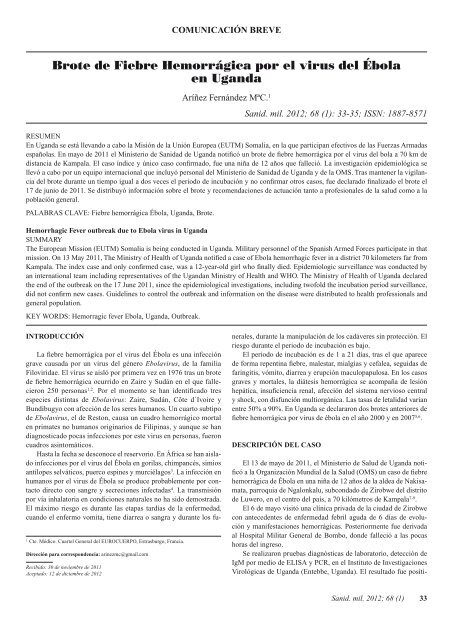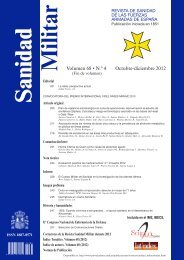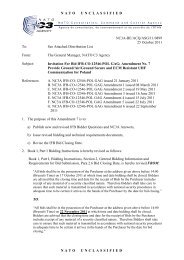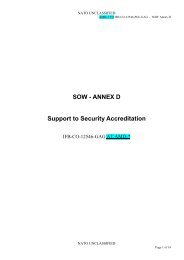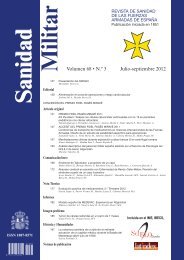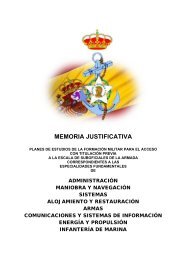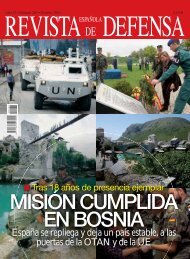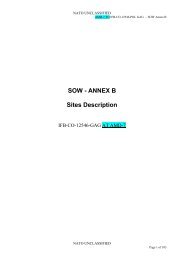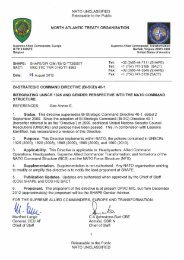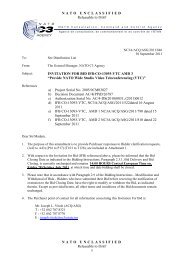Sanidad Militar - Ministerio de Defensa
Sanidad Militar - Ministerio de Defensa
Sanidad Militar - Ministerio de Defensa
You also want an ePaper? Increase the reach of your titles
YUMPU automatically turns print PDFs into web optimized ePapers that Google loves.
COMUNICACIÓN BREVE<br />
Brote <strong>de</strong> Fiebre Hemorrágica por el virus <strong>de</strong>l Ébola<br />
en Uganda<br />
Aríñez Fernán<strong>de</strong>z MªC. 1<br />
Sanid. mil. 2012; 68 (1): 33-35; ISSN: 1887-8571<br />
RESUMEN<br />
En Uganda se está llevando a cabo la Misión <strong>de</strong> la Unión Europea (EUTM) Somalia, en la que participan efectivos <strong>de</strong> las Fuerzas Armadas<br />
españolas. En mayo <strong>de</strong> 2011 el <strong>Ministerio</strong> <strong>de</strong> <strong>Sanidad</strong> <strong>de</strong> Uganda notificó un brote <strong>de</strong> fiebre hemorrágica por el virus <strong>de</strong>l bola a 70 km <strong>de</strong><br />
distancia <strong>de</strong> Kampala. El caso índice y único caso confirmado, fue una niña <strong>de</strong> 12 años que falleció. La investigación epi<strong>de</strong>miológica se<br />
llevó a cabo por un equipo internacional que incluyó personal <strong>de</strong>l <strong>Ministerio</strong> <strong>de</strong> <strong>Sanidad</strong> <strong>de</strong> Uganda y <strong>de</strong> la OMS. Tras mantener la vigilancia<br />
<strong>de</strong>l brote durante un tiempo igual a dos veces el periodo <strong>de</strong> incubación y no confirmar otros casos, fue <strong>de</strong>clarado finalizado el brote el<br />
17 <strong>de</strong> junio <strong>de</strong> 2011. Se distribuyó información sobre el brote y recomendaciones <strong>de</strong> actuación tanto a profesionales <strong>de</strong> la salud como a la<br />
población general.<br />
PALABRAS CLAVE: Fiebre hemorrágica Ébola, Uganda, Brote.<br />
Hemorrhagic Fever outbreak due to Ebola virus in Uganda<br />
SUMMARY<br />
The European Mission (EUTM) Somalia is being conducted in Uganda. <strong>Militar</strong>y personnel of the Spanish Armed Forces participate in that<br />
mission. On 13 May 2011, The Ministry of Health of Uganda notified a case of Ebola hemorrhagic fever in a district 70 kilometers far from<br />
Kampala. The in<strong>de</strong>x case and only confirmed case, was a 12-year-old girl who finally died. Epi<strong>de</strong>miologic surveillance was conducted by<br />
an international team including representatives of the Ugandan Ministry of Health and WHO. The Ministry of Health of Uganda <strong>de</strong>clared<br />
the end of the outbreak on the 17 June 2011, since the epi<strong>de</strong>miological investigations, including twofold the incubation period surveillance,<br />
did not confirm new cases. Gui<strong>de</strong>lines to control the outbreak and information on the disease were distributed to health professionals and<br />
general population.<br />
KEY WORDS: Hemorragic fever Ebola, Uganda, Outbreak.<br />
INTRODUCCIÓN<br />
1<br />
Cte. Médico. Cuartel General <strong>de</strong>l EUROCUERPO, Estrasburgo, Francia.<br />
Dirección para correspon<strong>de</strong>ncia: arinezmc@gmail.com<br />
Recibido: 30 <strong>de</strong> noviembre <strong>de</strong> 2011<br />
Aceptado: 12 <strong>de</strong> diciembre <strong>de</strong> 2012<br />
La fiebre hemorrágica por el virus <strong>de</strong>l Ébola es una infección<br />
grave causada por un virus <strong>de</strong>l género Ebolavirus, <strong>de</strong> la familia<br />
Filoviridae. El virus se aisló por primera vez en 1976 tras un brote<br />
<strong>de</strong> fiebre hemorrágica ocurrido en Zaire y Sudán en el que fallecieron<br />
250 personas 1,2 . Por el momento se han i<strong>de</strong>ntificado tres<br />
especies distintas <strong>de</strong> Ebolavirus: Zaire, Sudán, Côte d´Ivoire y<br />
Bundibugyo con afección <strong>de</strong> los seres humanos. Un cuarto subtipo<br />
<strong>de</strong> Ebolavirus, el <strong>de</strong> Reston, causa un cuadro hemorrágico mortal<br />
en primates no humanos originarios <strong>de</strong> Filipinas, y aunque se han<br />
diagnosticado pocas infecciones por este virus en personas, fueron<br />
cuadros asintomáticos.<br />
Hasta la fecha se <strong>de</strong>sconoce el reservorio. En África se han aislado<br />
infecciones por el virus <strong>de</strong>l Ébola en gorilas, chimpancés, simios<br />
antílopes selváticos, puerco espines y murciélagos 3 . La infección en<br />
humanos por el virus <strong>de</strong> Ébola se produce probablemente por contacto<br />
directo con sangre y secreciones infectadas 4 . La transmisión<br />
por vía inhalatoria en condiciones naturales no ha sido <strong>de</strong>mostrada.<br />
El máximo riesgo es durante las etapas tardías <strong>de</strong> la enfermedad,<br />
cuando el enfermo vomita, tiene diarrea o sangra y durante los funerales,<br />
durante la manipulación <strong>de</strong> los cadáveres sin protección. El<br />
riesgo durante el periodo <strong>de</strong> incubación es bajo.<br />
El periodo <strong>de</strong> incubación es <strong>de</strong> 1 a 21 días, tras el que aparece<br />
<strong>de</strong> forma repentina fiebre, malestar, mialgias y cefalea, seguidas <strong>de</strong><br />
faringitis, vómito, diarrea y erupción maculopapulosa. En los casos<br />
graves y mortales, la diátesis hemorrágica se acompaña <strong>de</strong> lesión<br />
hepática, insuficiencia renal, afección <strong>de</strong>l sistema nervioso central<br />
y shock, con disfunción multiorgánica. Las tasas <strong>de</strong> letalidad varían<br />
entre 50% a 90%. En Uganda se <strong>de</strong>clararon dos brotes anteriores <strong>de</strong><br />
fiebre hemorrágica por virus <strong>de</strong> ébola en el año 2000 y en 2007 5,6 .<br />
DESCRIPCIÓN DEL CASO<br />
El 13 <strong>de</strong> mayo <strong>de</strong> 2011, el <strong>Ministerio</strong> <strong>de</strong> Salud <strong>de</strong> Uganda notificó<br />
a la Organización Mundial <strong>de</strong> la Salud (OMS) un caso <strong>de</strong> fiebre<br />
hemorrágica <strong>de</strong> Ébola en una niña <strong>de</strong> 12 años <strong>de</strong> la al<strong>de</strong>a <strong>de</strong> Nakisamata,<br />
parroquia <strong>de</strong> Ngalonkalu, subcondado <strong>de</strong> Zirobwe <strong>de</strong>l distrito<br />
<strong>de</strong> Luwero, en el centro <strong>de</strong>l país, a 70 kilómetros <strong>de</strong> Kampala 7-9 .<br />
El 6 <strong>de</strong> mayo visitó una clínica privada <strong>de</strong> la ciudad <strong>de</strong> Zirobwe<br />
con antece<strong>de</strong>ntes <strong>de</strong> enfermedad febril aguda <strong>de</strong> 6 días <strong>de</strong> evolución<br />
y manifestaciones hemorrágicas. Posteriormente fue <strong>de</strong>rivada<br />
al Hospital <strong>Militar</strong> General <strong>de</strong> Bombo, don<strong>de</strong> falleció a las pocas<br />
horas <strong>de</strong>l ingreso.<br />
Se realizaron pruebas diagnósticas <strong>de</strong> laboratorio, <strong>de</strong>tección <strong>de</strong><br />
IgM por medio <strong>de</strong> ELISA y PCR, en el Instituto <strong>de</strong> Investigaciones<br />
Virológicas <strong>de</strong> Uganda (Entebbe, Uganda). El resultado fue positi-<br />
Sanid. mil. 2012; 68 (1) 33


